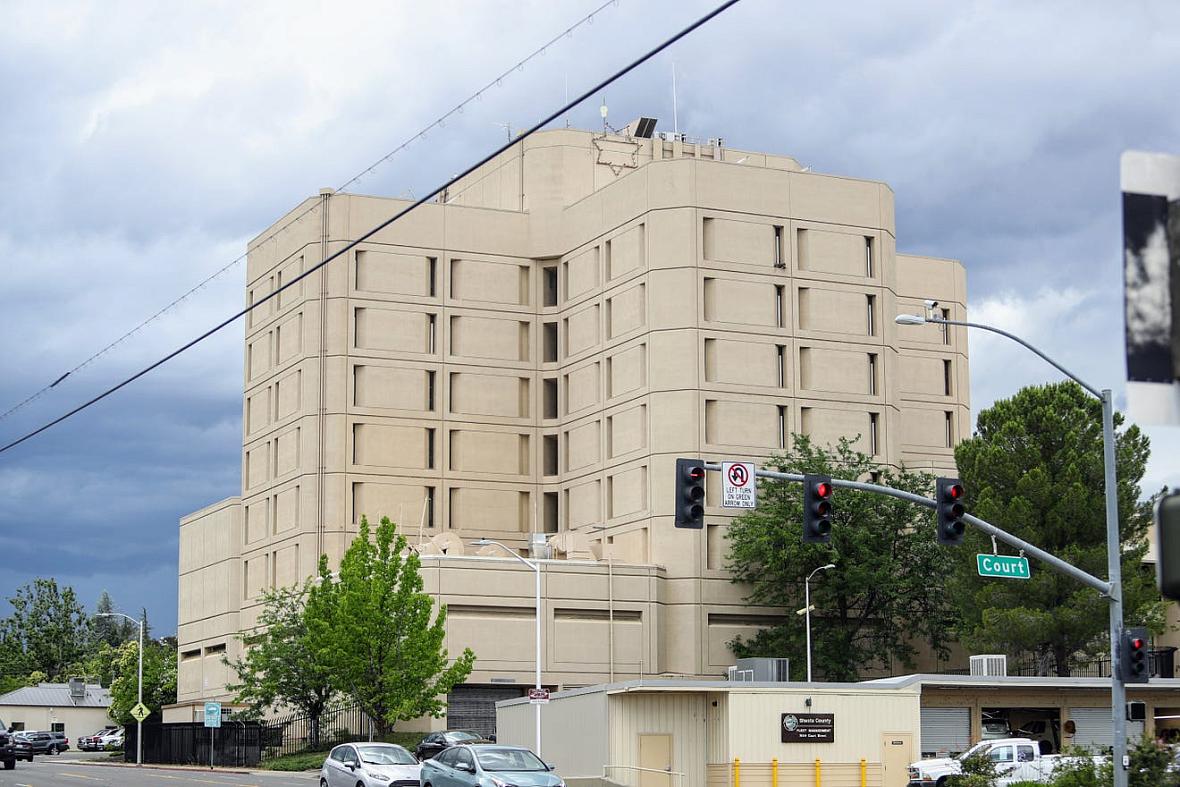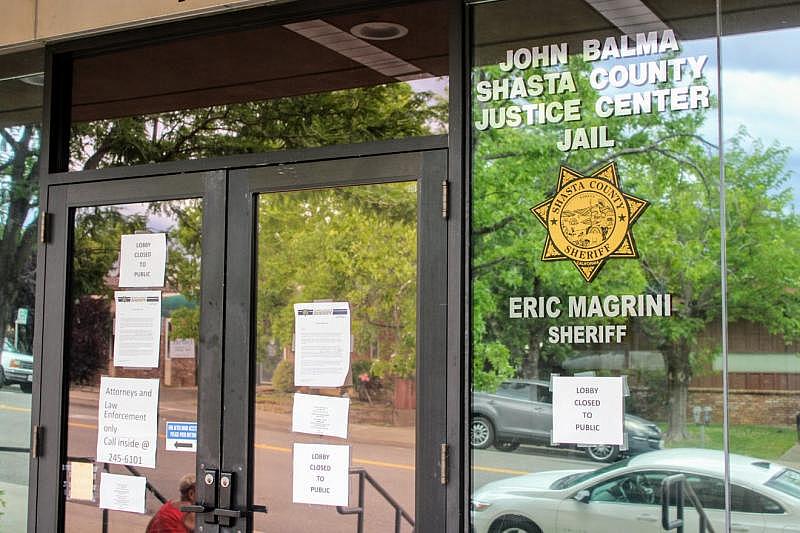Shasta County Jail: Two important areas of policy to understand
This story is produced as part of a larger project by Matthew Brannon, a participant in the 2020 California Fellowship.
His other stories include:
Part 1: Dying Inside: Why are more deaths happening in Shasta County Jail custody?
Callout: What do you want us to know about jails in Northern California?
Part 2: Analysis reveals disparities among death rates in California county jails
Part 3: With jail deaths on the rise, California counties look to improve

Shasta County Jail on June 12, 2020
Matt Brannon/ Record Searchlight
Shasta County has one of the highest arrest rates of any California county. Research from 2016 shows the county’s arrest rate was nearly double the state average. Only two other counties, Lake and Siskiyou, detained a higher share of residents.
Whatever the reason, the result is more people in Shasta County Jail custody. The jail is tasked with ensuring people in its care get emergency and basic health care services, including dental and mental health. There’s rarely fewer than 400 people in jail at any time, and jail officials and experts agree that many come into the system already in poor health.
In recent years, the jail has also seen the number of deaths in custody tick upward. From 2005 to 2012, the jail reported nine deaths. From 2013 to 2019, it reported 16. Most of those deaths are suicides, a category of deaths some jail experts have deemed “mostly preventable.”
In addition to interviewing officials and independent experts, the Record Searchlight heard from about 20 people who had either served time in the jail or had a loved one serve time. Several of them cited problems accessing medications. Others highlighted mental health issues.
To help readers get a better sense of how the jail addresses these issues, here are two relevant policy areas to understand: Medication and suicide prevention.
Prescribing medications
When someone is arrested, they’re screened by a correctional officer at the jail before being booked into the facility. The officer, trained by the jail’s healthcare provider, Wellpath, will go over a list of questions with the person, asking about medical and mental health history, including potential for suicidal behavior.
The officers aren’t required to ask what medications the person takes, but if the arrestee mentions them, an officer can notify the jail’s medical staff. After that, there’s also private screening for disability or mobility issues, according to Cpt. Gene Randall, who oversees the jail for the Shasta County Sheriff’s Office.
That’s how it worked before COVID-19. Since then, the jail also has a nurse ask about potential symptoms and perform a temperature check, Randall said.
Randall said medications are generally confiscated at the time of booking and placed with the rest of a person’s property if it is identifiable.
However, Randall said there is a provision in the jail policy with the approval of health services that can allow a person to keep up to three doses of certain medications if in a properly marked bottle. Although he said that’s rare.
Certain other jails allow family members to bring medications to the facility, at which point a staff member will then verify the prescription with a pharmacy or doctor, before it can be accessed by the person in custody. Randall said that isn’t done at the Shasta County Jail. He noted the jail already has medical staff available at all times. He also said it is a security issue.
Instead to access medications, Randall said people in custody can use their jail-issued tablet to schedule medical appointments. It would be up to the medical provider to determine what medications are prescribed, he said.
Scheduling medical care works on a priority basis, so emergencies can be addressed right away and for lower priority calls Randall said it could take a couple days to be seen, depending on the patient load for Wellpath.
If a person in custody believes they need a medication and Wellpath's medical staff disagrees, the lone recourse is filing a grievance through their jail-issued tablet. However, Randall said he's unaware of any instances in which a person who didn't get a medication filed a grievance and later received it.
Randall also noted that health staff does a medical evaluation at the 10-day mark of incarceration to identify potential medical or psychological problems.
Suicide prevention
Randall said correctional officers are trained on suicide prevention in the academy and when hired to the jail, with the latter process usually lasting about three and a half months. Every two years, the staff gets a refresher training on medical issues in jail that covers suicide prevention and signs of distress.
However, Randall said he would like to see a more robust training, possibly once or twice each year.
“We definitely want to step that up and that’s the conversation we’re going to be having in January,” he said.
Randall said in January he wants work with jail supervisors to further develop suicide prevention policies to make sure staff can identify behaviors associated with suicidal behavior.
The current policy for suicide prevention begins with the health screening performed by the correctional officer. Officers are told to look for any history or indication of suicidal behavior.
If officers catch suicidal behaviors or the person talks about them, the officer can refer them to a mental health professional from Wellpath. If no mental health staff is available, the nursing staff will use a psychiatric suicide assessment tool for those identified as exhibiting signs of suicide potential.
Randall noted that there are signs in high-traffic areas of the jail identifying different behaviors associated with anxiety and depression and how to reach out for help. Once someone tells the staff they’re suicidal, Randall said the person is moved downstairs to a medical unit where they can talk with a mental health professional.
Treatments and procedures for those showing signs of suicide can include the following, according to jail training materials: Placement on suicide watch if warranted, a scheduled welfare check, regular physical health checks and regular mental health assessments to include psychiatry when needed.
Shasta County Jail on June 12, 2020 Matt Brannon/Record Searchlight
That information comes from a slideshow of training materials by California Forensic Medical Group, a previous iteration of Wellpath before a merger and name change.
Any further treatment procedures are unclear. The following slide in the “Suicide & Incarceration” training presentation was redacted in a public records request response, as Wellpath asserted it falls within the definition of a trade secret, according to the sheriff’s office.
When someone is placed on suicidal precautions at the jail, Randall said they’re generally housed alone for safety reasons. They’re checked on twice every 30 minutes by staff. A mental health professional will then deem when they’re fit to go back to their housing unit, he said.
Generally, different jails vary in their suicide prevention policies. Some experts have argued that isolating suicidal people in a cell is detrimental because it can increase a sense of alienation.
“To every extent possible, suicidal inmates should be housed in the general population, mental health unit, or medical infirmary, located close to staff,” wrote Lindsay Hayes, a nationally recognized expert on suicides in corrections.
Hayes cited research suggesting people in custody are reluctant to discuss suicide because of harsh conditions on suicide precautions, with 75% of those in jail saying they did not want to be transferred to an observation cell, according to one survey.
Other helpful things to know
For visitation: When visiting someone in jail, it’s first come, first serve so visitors arriving earlier have a better chance of seeing someone that day. Be ready to go through a metal detector. If bringing children, ensure they won’t be disruptive. More rules can be found on the sheriff’s website.
For commissary: People with funds posted on their jail accounts and not on disciplinary restriction can purchase approved items through commissary. Information on how to get money on an account is available on the sheriff’s website or by calling the jail at 530-245-6100. Commissary orders are placed on Sundays. The following items are available at the jail, according to sheriff’s office policy: shoes, tumblers, deodorant, denture cleaner, saline solution, foot powder, denture bath, lip balm, hair brush, denture adhesive, lotion, shampoo, shaving cream, conditioner, heritage cream, hair tie, soap, batteries, 10% acne, soap dish, toothpaste, radio, toothbrush, hair dressing, decks of cards, earbuds, comb, thongs, multi-vitamin bottles.
For grievances: If a person in custody has a grievance with the jail, they can file a form with the jail staff through their tablet. If an inmate isn't satisfied with the response from deputies, they can appeal to the jail's watch commander. If still unsatisfied, they can appeal with the facility manager. If still unsatisfied with the response, they can appeal the decision by way of a Writ of Habeas Corpus, which can be obtained through a housing deputy.
Other resources
The Commons is a non-profit organization with the mission to support families who have a loved one in jail or prison (SupportTheCommons.org).
Shasta County Public Defender's Office provides legal services, including criminal defense, for those to whom it has been appointed by a court due to inability to afford a private attorney (co.shasta.ca.us/index/public-defender or 530-245-7598).
ACLU of Northern California advocates for civil rights and liberties. Its legal department generally does not handle criminal defense but participates in high-impact cases that defend and promote civil rights and individual liberties (ACLUNC.org or 415-621-2493).
Prison Policy Initiative is a nonprofit that researches mass incarceration. It has a list of free legal resources on its website (PrisonPolicy.org/resources/legal).
Legal Services for Prisoners with Children advocates to release incarcerated people and reunify families and communities (PrisonersWithChildren.org or 415-255-7036).
Prison Law Office is a nonprofit that protects the rights of people behind bars through advocacy, education and litigation (PrisonLaw.com/resources).
ProPublica/Sacramento Bee created a guide with tips on navigating California county jails (link).
Google results for Shasta County bail bonds (link).
Shasta County's website lists the following phone numbers for people who might have suicidal thoughts and want to talk to someone: Redding-based Help Inc. at 530-244-2222 or the National Suicide Prevention Lifeline at 1-800-273-TALK (8255).

